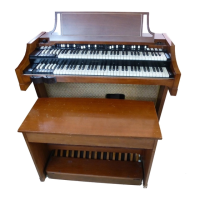
Do you have a question about the Hammond Organ A-100 Series and is the answer not in the manual?
| Tonewheel Generator | Yes |
|---|---|
| Manuals | Two |
| Drawbars | 9 per manual |
| Built-in Effects | Vibrato/Chorus |
| Amplification | Built-in |
| Speaker | Built-in |
| Percussion | Second and Third Harmonic |
Explains electrical tone generation via phonic wheels and signal processing.
Details the procedure for turning on the organ using specific switches.
Explains the function and operation of the preset keys for tone selection.
Describes the drawbars used for the pedal keyboard and their function.
Explains the normal/soft volume control and the swell pedal for volume adjustment.
Details the vibrato effect, its comparison to tremolo, and its mechanism.
Explains the "Touch-Response Percussion" feature and its controls.
Describes the main tone generator, its frequencies, filters, and components.
Explains the power amplifier, reverberation amplifier, and the reverberation system's operation.
Covers connecting external tone cabinets and the echo control feature.
Covers power connection, anchoring, generator lubrication, and lamp replacement.
Introduces the electro-mechanical tone generator assembly and its mounting.
Explains the function and operation of the starting and synchronous motors.
Details the tone wheel assemblies, construction, and lubrication requirements.
Explains the function of generator filters and the magnet gap setting.
Details the manual chassis, key contacts, and busbar connections for signal transmission.
Describes how keys, preset keys, and drawbars interact to control tone.
Explains the busbar shifter for contact cleaning and troubleshooting noisy notes.
Explains how preset keys are wired to the preset panel for tone combinations.
Details the mechanical operation and construction of preset keys.
Details the pedal switch assembly, its contacts, and wiring to pedal drawbars.
Explains the pedal circuits, resistor panel, and filtering for pedal tones.
Explains pedal key tension adjustment.
Details the vibrato effect, phase shifting, and scanning mechanism.
Describes the vibrato line box and its filter sections.
Shows the construction of the vibrato switch.
Explains the construction and operation of the vibrato scanner.
Explains how percussion tones are produced by borrowing harmonic signals.
Explains the general circuit operation for percussion tones.
Details the functions of various percussion control tablets and cutoff adjustments.
Covers adding earphones and using the phono input jack.
Lists available schematics for the organ models.
